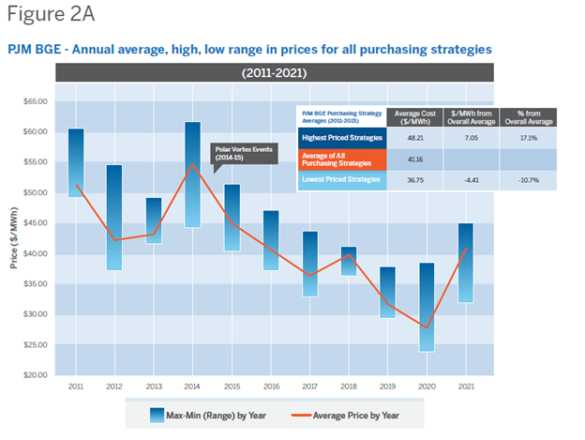The Value of a Managed Energy Purchasing Strategy
3 min readPower prices are always moving. The past several years we’ve seen historically high energy prices as natural gas supply and demand has reached record highs, conflict in Europe has caused increased exports and weather patterns are becoming more volatile and unpredictable. Natural gas fired power plants are expected to be the largest source of power generation in the U.S. at about 38% of the market in 2023, according to the EIA’s Short-Term Energy Outlook (STEO).
Staying on top of these factors and more makes power procurement a daunting task at times. Even full-time stock analysts and sports handicappers are right about 50% of the time. A single “bad” choice on when to lock-in forward power supply can cost your company thousands of dollars today, and into the future, depending on how long your retail contract lasts. So, how do energy buyers mitigate such risk?
A “bad” choice on when to buy can cost your company thousands of dollars today…and into the future.
Why a Managed Purchasing Strategy Works
By deploying a managed, or layered power purchasing strategy, energy buyers can effectively manage risk and price. A managed strategy can take a variety of forms—from simple and manual to very complex and automated. The key is that you take a managed approach when buying portions of your future power usage or load.
One simple purchasing strategy to consider is this: instead of looking at buying energy once a year, or every other year, spread your risk and purchasing over time by layering or locking in percentages of your load over time, thereby proactively managing exposure to fluctuating market rates. Doing so provides increased control over energy price changes and spreads out overall risk in both price and timing.
To be successful, decision-makers in the competitive power markets will need to become increasingly market savvy when it comes to their procurement strategies. Use of more complex market-based concepts and layering-in strategies will become increasingly important. Power buyers will also need to become increasingly familiar with how the financial markets are influencing the capital investments in the energy production sector with changing ROI expectations and the increasing emphasis on ESG. Constellation will continue to monitor and report on these metrics and provide our customers the latest trends impacting power purchasing decisions.
Check out Figure 2A from Constellation’s recently published Energy Purchasing White Paper below where you can see that impact of having a managed purchasing strategy in place can not only significantly lower risk but can also make a big difference in the final outcome in in overall costs.
Figure 2A. Constellation’s Evaluating Power Purchasing Strategies for Your Business White Paper

Download our Evaluating Power Purchasing Strategies for Your Business for a detailed look into how managed strategies performed over a 10-year period.
How to Get Started on Your Strategy
To get started on creating a managed strategy, you should first look at your power usage monthly, seasonality, and possibly even at the hourly level. From there, your business’ financial budget is an important driver. At that point, we estimate an effective strategy can be developed with about 20 hours per year of effort, and your Constellation business development manager can guide you along the way.
Additionally, look at the economic and natural gas and power conditions, as well as upcoming weather forecasts impacting energy prices. Constellation updates energy managers with this information every month during our Energy Market Intel Webinars. Knowing the current trends and what’s expected to come are all important to consider when strengthening your energy strategy.
For customers that want further assistance, we also provide a variety of tools to help plan, measure and adjust their strategy over time. Our Information-to-implementation (i2i) is a no-cost reporting service to help you plan your budget and make informed purchasing decisions. One component of the service is the Energy Strategy Planner, which shows your usage and cost over a period of time, typically five years, identifying your expected budget costs under a variety of plans.
In moving forward with a power purchasing strategy, it’s important for customers to have a clear understanding of their load shape, risk tolerance and pricing goals and then put in place a managed strategy to both the layering in of purchases at fixed prices and any portions of the load at index prices. By thoughtfully approaching these factors, you can implement a plan that makes the most sense for your business. For help with your power purchasing strategy, get in touch with your Constellation representative by visiting our website.

